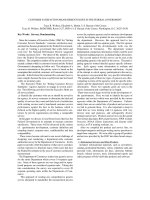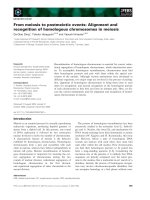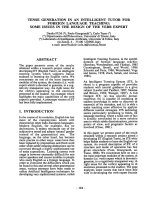planning systems facing heritage issues in europe from protection to management in the plural interpretations of the values of the past
Bạn đang xem bản rút gọn của tài liệu. Xem và tải ngay bản đầy đủ của tài liệu tại đây (210.21 KB, 4 trang )
EUROPEAN SPATIAL RESEARCH AND POLICY
Volume 21
2014
Number 2
10.1515/esrp-2015-0001
PART I
PLANNING SYSTEMS FACING HERITAGE ISSUES IN EUROPE:
FROM PROTECTION TO MANAGEMENT, IN THE PLURAL
INTERPRETATIONS OF THE VALUES OF THE PAST
Guest editor: Anna GEPPERT
FOREWORD
The present issue of European Spatial Research and Policy is the first of two
numbers dedicated to ‘Planning systems facing heritage issues in Europe: from
protection to management, in the plural interpretations of the values of the past’.
The concept arose from a meeting held in June 2013 at the conference on ‘Changing Cities’ in Skiathos, Greece, where a group of planners decided to compare the
experiences we have at the interface between heritage and planning in a range of
European countries.
European societies are becoming increasingly fond of the historical dimension of their cities. Traces from the past, both physical and cultural, are cherished
because they are carrying territorial identities. This evolution has reached the European discourse, with the Florence convention of the Council of Europe (2000),
as well as the Leipzig Charter on Sustainable European Cities, which states in
its Preamble that ‘Our cities possess unique cultural and architectural qualities,
strong forces of social inclusion and exceptional possibilities for economic development’ (Informal Council of the Ministers in charge of Urban Development of
the European Union, 2007).
At the global level, UNESCO promotes a similar vision. The Recommendation
on the Historic Urban Landscape (2011) defines historic urban landscape:
[…] the urban area understood as the result of a historic layering of cultural and natural values
and attributes, extending beyond the notion of ‘historic centre’ or ‘ensemble’ to include the broader
urban context and its geographical setting. This wider context includes notably the site’s topography,
geomorphology, hydrology and natural features, its built environment, both historic and contemporary, its infrastructures above and below ground, its open spaces and gardens, its land use patterns
and spatial organization, perceptions and visual relationships, as well as all other elements of the
- 10.1515/esrp-2015-0001
Downloaded from De Gruyter Online at 09/12/2016 01:08:09AM
via Universidade de Pernambuco UPE
10
Foreword
urban structure. It also includes social and cultural practices and values, economic processes and the
intangible dimensions of heritage as related to diversity and identity (Articles 8 and 9).
But does ‘cultural practices and values’ have the same meaning in all European
countries? Indeed, similar evolutions can be witnessed. Since the 19th century,
most European countries have protected outstanding natural sites, architectural
monuments and urban landscapes. Progressively, humble traces of daily life are
being considered heritage, because they are representative of collective memories
and identities: post-industrial neighbourhoods, modernistic settlements, rural areas etc. Authentic or fake historicity becomes a driver of regeneration strategies
and territorial branding. Rather than strict protection, usually in the hands of national authorities, these landscapes call for planning and management.
However, so far, the situation is not homogeneous. The aim of this issue is
threefold. On the one hand, we wish to compare the values underpinning national
definitions of, and approaches to, heritage. On the other hand, we intend to compare how different European planning systems respond to this evolution. Finally,
we wonder how the context, institutional, social, economic – not a minor element
in these times of crisis – impacts the protection and management of cultural landscapes.
Suzanna Alves brings to the debate a concept derived from ecological psychology – affordance analysis. Historic urban landscapes appear as affordances,
or potentials of a place. The definition of tangible and intangible values results
from a transaction between the diversity of members of the society. The planner is
then the mediator of this ‘transaction’. Public spaces, vacant spaces, ‘in-between
spaces’, become essential places for its realisation and the constant re-creation of
collective identities.
Pablo Alonso Gonzalez focuses on a trans-Atlantic comparison of cultural
parks, an object between heritage and planning, often used for place-branding. He
suggests that albeit each European country has its institutional setting and national
traditions, Europe and the United States feature different ideal-types. In Europe,
institutional stakeholders prevail in defining and implementing policies, while in
the US, cultural parks are mainly stemming from local initiatives. However, reciprocal influences exist and may generate some cross-contamination.
Two papers address the management of sites from the UNESCO World Heritage List, showing quite different dynamics. From an Italian perspective, Francesco Lo Piccolo and Vincenzo Todaro analyze the tension between Management
Plans, based on a performative model, and planning instruments and tools, very
conformative. This hampers integration between management plans and the planning system, which leads to a loss of efficiency in their implementation, eventually even a loss of meaning, when Management Plans become ‘a collection of
goals derived from pre-existing planning and programming tools’.
- 10.1515/esrp-2015-0001
Downloaded from De Gruyter Online at 09/12/2016 01:08:09AM
via Universidade de Pernambuco UPE
Foreword
11
From an Austrian perspective, Sibylla Zech, Gisa Ruland and Peter Kurz show
how, in the Hallstatt-Dachstein region, the inscription on the UNESCO World Heritage List has fostered the emergence of a regional development strategy built on a consensus between stakeholders. Public participation and good governance are the key of
success and the authors suggest a series of principles which may help in achieving it.
Yet, is not heritage a luxury for wealthy societies? The strike back of social
and economic realities is addressed by Vojtech Novotný, Alca Wranová, and Jika
Trevisan. On the case of Mšeno (Czech Republic), they show how the 19th century heritage is being damaged, in spite of a strong ‘expert, top-down and repressive’ protection. The main reason is the resistance of the owners, for whom the
cultural value is, before anything else, a heavy financial cost. The tension is worsened by the distrust between citizens and public authorities, due in particular to
the precedent of some building permissions perceived as arbitrary.
From a Greek perspective, Ioanna Katapidi shows how, despite conservation
policies, cultural and environmental values of landscapes are threatened by urban
development. Analyzing the case of Mount Pelion, she elaborates a typology of
problems coming from development, underdevelopment, administration, and the
still vivid illegal sphere. She shows that sectoral regulations, environmental or
cultural, are not sufficient as long as they remain fragmented and disconnected
from social and economic realities.
To what extent are these differences linked to the differences between planning cultures? According to the European Compendium of Planning Systems (European Commission, 1997), the Austrian system embodies the ‘comprehensive
integrated approach’, where public participation and policy integration prevail.
Italy and Greece represent the ideal-type of ‘urbanism’, where statutory plans are
legally dominant, yet challenged by informal developments and deals. The Czech
planning system illustrates the ‘Land use management’ model, where local authorities have some flexibility in the delivery of building permits. As a result, in
the post-socialist context, the suspicion of corruption is never far away.
Beyond the particularities, are there lessons to be learned from one country to
another? Is a common understanding of heritage emerging? Is there a convergence
with respect to heritage planning and management? The forthcoming issue of this
journal will bring additional light to these questions.
References
COUNCIL OF EUROPE (2000), European Landscape Convention adopted by the Committee of
Ministers of the Council of Europe on 19 July 2000 and opened for signature by its Member
States in Florence on 20 October 2000, />htm (20.10.2014).
- 10.1515/esrp-2015-0001
Downloaded from De Gruyter Online at 09/12/2016 01:08:09AM
via Universidade de Pernambuco UPE
12
Foreword
EUROPEAN COMMISSION (1997), European Union, Regional Policy and Cohesion. The EU
Compendium of Spatial Planning Systems and Policies, Luxembourg: Office for Official Publications of the European Communities, Lanham, MD: Bernan Associates [distributor].
INFORMAL COUNCIL OF THE MINISTERS IN CHARGE OF URBAN DEVELOPMENT OF
THE EUROPEAN UNION (2007), Leipzig Charter on Sustainable European Cities, adopted
by the European ministers responsible for urban policy on 24 May 2007, />regional_policy/archive/themes/urban/leipzig_charter.pdf (20.10.2014).
UNESCO (2011), Recommendation on the Historic Urban Landscape, including a glossary of definitions, Resolution of the General Conference adopted on the report of the CLT Commission
at the 17th plenary meeting, on 10 November 2011, />ID=48857%26URL_DO=DO_TOPIC%26URL_SECTION=201.html (20.10.2014).
Anna GEPPERT*
1
*
Anna GEPPERT, Université Paris-Sorbonne, Institut de Geographie, (9) Rue St Jacques, 75005
Paris, France, e-mail:
- 10.1515/esrp-2015-0001
Downloaded from De Gruyter Online at 09/12/2016 01:08:09AM
via Universidade de Pernambuco UPE









